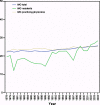The United States physician workforce and international medical graduates: trends and characteristics
- PMID: 17356997
- PMCID: PMC1824721
- DOI: 10.1007/s11606-006-0022-2
The United States physician workforce and international medical graduates: trends and characteristics
Abstract
Background: International medical graduates (IMGs) have been a valuable resource for the United States physician workforce, and their contribution to the United States workforce is likely to increase.
Objective: To describe the historical trends and compare the characteristics of IMGs to United States medical graduates (USMGs) in the United States.
Design: Longitudinal analysis of the American Medical Association Physicians' Professional Data (AMA-PPD) database using the 1978-2004 files and a comparative analysis of the characteristics of a random sample of 1,000 IMGs and a random sample of 1,000 USMGs using the 2004 file.
Measurements: Historical trends and characteristics of IMGs in the United States.
Results: Over the last 26 years, the number of IMGs in the United States grew by 4,873 per year reaching a total of 215,576 in 2004, about 2.4 times its size in 1978. The proportion of IMGs increased 0.12% per year, from 22.2% in 1978 to 25.6% in 2004. In 2004, compared with USMGs, IMGs were older, less likely to be board certified [Odds ratio (OR), 0.68; 95% CI, 0.53 to 0.86], less likely to work in group practice (OR, 0.60; 95% CI, 0.37 to 0.98), more likely to have Internal Medicine as practice specialty (OR, 2.10; 95% CI, 1.62 to 2.71) and more likely to be residents (OR, 1.52; 95% CI, 1.07 to 2.16).
Conclusions: Over the last quarter century, the IMGs provided a significant and steady supply for the United States physician workforce that continues to grow. Policymakers should consider the consequences for both the United States and source countries.
Figures


References
-
- {'text': '', 'ref_index': 1, 'ids': [{'type': 'DOI', 'value': '10.1001/jama.265.18.2369', 'is_inner': False, 'url': 'https://doi.org/10.1001/jama.265.18.2369'}, {'type': 'PubMed', 'value': '1901922', 'is_inner': True, 'url': 'https://pubmed.ncbi.nlm.nih.gov/1901922/'}]}
- Grumbach K, Lee PR. How many physicians can we afford? JAMA. 1991;265:2369–72. - PubMed
-
- Graduate Medical Education National Advisory Committee. Summary report of the Graduate Medical Education National Advisory Committee to the Secretary, Department of Health and Human Services. Washington, D.C. April 1981.
-
- American Association of Colleges of Osteopathic Medicine, American Medical Association, American Osteopathic Association, Association of Academic Health Centers, Association of American Medical Colleges, National Medical Association. Consensus Statement on Physician Workforce. Washington, DC; 1997.
-
- {'text': '', 'ref_index': 1, 'ids': [{'type': 'PubMed', 'value': '15520427', 'is_inner': True, 'url': 'https://pubmed.ncbi.nlm.nih.gov/15520427/'}]}
- Cooper RA. Weighing the evidence for expanding physician supply. Ann Intern Med. 2004;141:705–14. - PubMed
-
- {'text': '', 'ref_index': 1, 'ids': [{'type': 'DOI', 'value': '10.1001/jama.290.22.2992', 'is_inner': False, 'url': 'https://doi.org/10.1001/jama.290.22.2992'}, {'type': 'PubMed', 'value': '14665661', 'is_inner': True, 'url': 'https://pubmed.ncbi.nlm.nih.gov/14665661/'}]}
- Cooper RA, Stoflet SJ, Wartman SA. Perceptions of medical school deans and state medical society executives about physician supply. JAMA. 2003;290:2992–5. - PubMed
Publication types
MeSH terms
LinkOut - more resources
Full Text Sources

